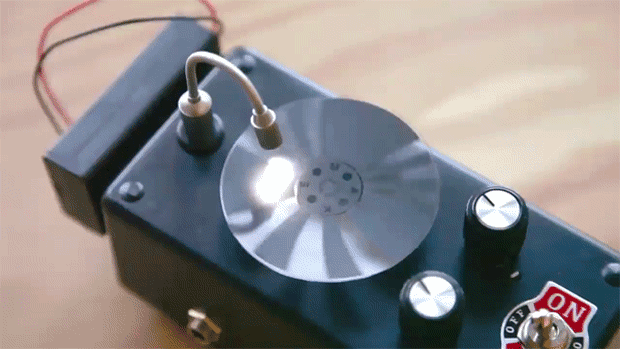
Join Make: Community Today
The Optical Tremolo Box was inspired by Charles Platt’s “Stomp Box Basics” article (MAKE Volume 15, page 82), which theorized using a light sensor to read patterns on a rotating disk to create a tremolo effect. In amplifiers and effects pedals, tremolo is basically rapid fluctuations of volume to create a warbling, or “shudder” effect. Taking the project from theory to reality, MAKE Technical Editor Sean Ragan used a cadmium sulfide photoresistor to provide us with our light sensor — a component we have used in previous Weekend Projects. Combined with “sweep disks” that vary the light passing through to the photoresistor, you can create custom tremolo effects!
Chat LIVE with Makers
Join us this Friday, November 15th at 3:30pm PT/6:30pm ET as we chat live with makers Charles Platt and Sean Ragan to discuss the Optical Tremolo Box and stomp box designs. Attend the event on Google+ and you can watch live and ask the makers any questions you have about their projects.
Many Types of Tremolo
Tremolo itself is found in many instruments, and includes most types of drum rolls, some singing techniques, “bends above the nut” on a guitar, or tuned and detuned ranks of pipes of an organ. It can also be produced with synthesizers. As a classical guitar technique, tremelo is perhaps best known by Francisco Tárrega’s Recuerdos de la Alhambra.
While the DeArmond control box seen above sounds something like this:
Homemade Tremolo
Whether you’re an audio enthusiast or just looking for a project to build this weekend, watch the video below to see – and hear! – the Optical Tremolo Box in action. Customize your box enclosure, or take it to the next level like maker Chuck did a year ago with his upcycled dummy discs tremolo box.

14 thoughts on “From DeArmond to Photoresistors, the Optical Tremolo Box Looks and Sounds Great!”
Comments are closed.
ADVERTISEMENT
Join Make: Community Today











Repost from last year? https://makezine.com/2012/08/23/build-a-custom-tremolo-effects-box/
Hi Brett,
The “repost” is to give context for Friday’s Hangout with Platt and Ragan, along with embedded audio content and new links. I wrote both posts. Thanks for reading.
Makes sense now, thanks ;-)
This is still one of my favorite projects! I want to combine the optical tremolo with the voice remover circuit from last week to create an auto-panning effect between two amps. Keep the fun stuff coming- analog and physical effects add a depth to a recording that digital effects can’t quite replicate.
Always great to read your comments on the blog Chuck. I agree there’s a certain beauty to the effects created with these analog devices. Thanks for reading!
It probably bears mentioning that dropping a resistor across the output of a guitar tends to change the resonant peak of the pickups with a possible negative change in tone (perceived as a loss of treble or volume). This problem can be avoided by using any active buffer (such as a Boss pedal) or any guitar pedal that’s turned on before the tremolo effect (or, if you want a stand alone solution, mounting an input buffer inside the
(sorry, got distracted) mount an input buffer, such as the Orman buffer available as a simple PCB, inside between the input and the LDR.